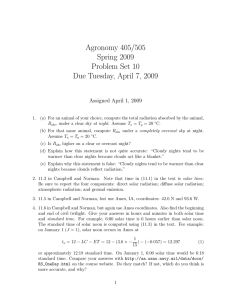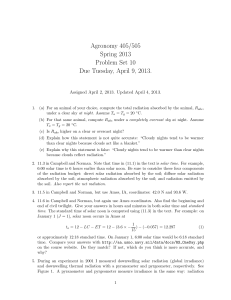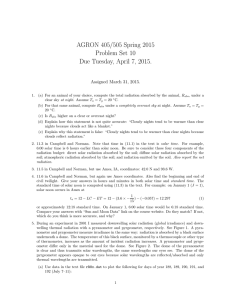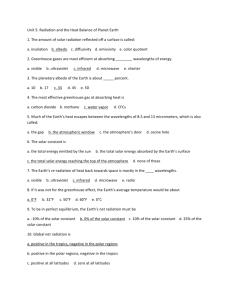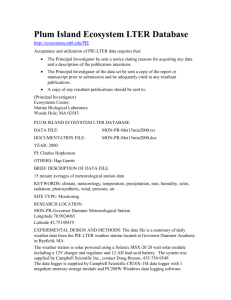Agronomy 405/505 Spring 2011 Problem Set 10 Due Tuesday, April 5, 2011.
advertisement
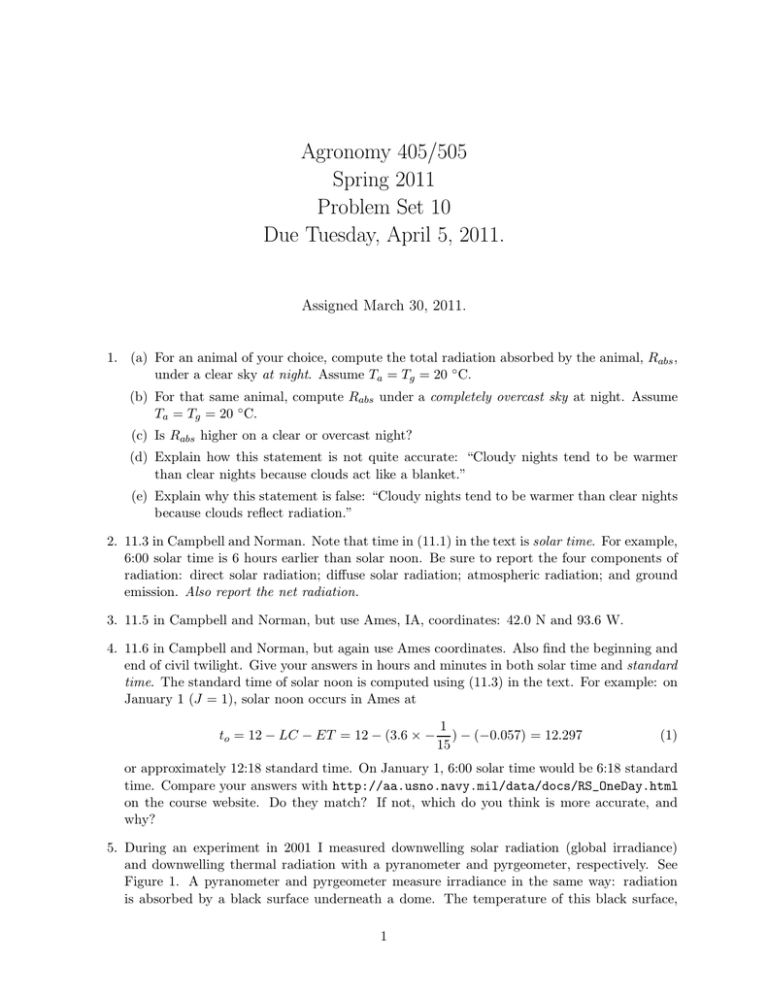
Agronomy 405/505 Spring 2011 Problem Set 10 Due Tuesday, April 5, 2011. Assigned March 30, 2011. 1. (a) For an animal of your choice, compute the total radiation absorbed by the animal, Rabs , under a clear sky at night. Assume Ta = Tg = 20 ◦ C. (b) For that same animal, compute Rabs under a completely overcast sky at night. Assume Ta = Tg = 20 ◦ C. (c) Is Rabs higher on a clear or overcast night? (d) Explain how this statement is not quite accurate: “Cloudy nights tend to be warmer than clear nights because clouds act like a blanket.” (e) Explain why this statement is false: “Cloudy nights tend to be warmer than clear nights because clouds reflect radiation.” 2. 11.3 in Campbell and Norman. Note that time in (11.1) in the text is solar time. For example, 6:00 solar time is 6 hours earlier than solar noon. Be sure to report the four components of radiation: direct solar radiation; diffuse solar radiation; atmospheric radiation; and ground emission. Also report the net radiation. 3. 11.5 in Campbell and Norman, but use Ames, IA, coordinates: 42.0 N and 93.6 W. 4. 11.6 in Campbell and Norman, but again use Ames coordinates. Also find the beginning and end of civil twilight. Give your answers in hours and minutes in both solar time and standard time. The standard time of solar noon is computed using (11.3) in the text. For example: on January 1 (J = 1), solar noon occurs in Ames at to = 12 − LC − ET = 12 − (3.6 × − 1 ) − (−0.057) = 12.297 15 (1) or approximately 12:18 standard time. On January 1, 6:00 solar time would be 6:18 standard time. Compare your answers with http://aa.usno.navy.mil/data/docs/RS_OneDay.html on the course website. Do they match? If not, which do you think is more accurate, and why? 5. During an experiment in 2001 I measured downwelling solar radiation (global irradiance) and downwelling thermal radiation with a pyranometer and pyrgeometer, respectively. See Figure 1. A pyranometer and pyrgeometer measure irradiance in the same way: radiation is absorbed by a black surface underneath a dome. The temperature of this black surface, 1 monitored by a thermocouple or other type of thermometer, increases as the amount of incident radiation increases. A pyranometer and pyrgeometer differ only in the material used for the dome. See Figure 2. The dome of the pyranometer is clear and thus transmits solar wavelengths, the same wavelengths our eyes see. The dome of the pyrgeometer appears opaque to our eyes because solar wavelengths are reflected/absorbed and only thermal wavelengths are transmitted. (a) Use data in the text file rR8x.dat (suitable for use in either MATLAB or Excel or similar program) to plot the net radiation at the top of the vegetation canopy for days of year 190, 191, and 192 (July 9–11): 4 Rn = S + A − aS + σ Tveg . (2) Here S = the downwelling solar radiation, A = the downwelling thermal radiation, a is the albedo of the vegetation canopy, and Tveg is the temperature at the top of the vegetation canopy. Read the comments in rR8x.dat to determine which variables to use. Note that we are assuming a thermal emissivity of unity for the vegetation canopy. (b) During what period of the day (approximately) is the net radiation positive? (c) What happens to the energy associated with the positive net radiation? (d) During what period of the day (approximately) is the net radiation negative? (e) What is happening (physically) when the net radiation is negative? MATLAB suggestions: use load rR8x.dat and use my function timeconvert.m on the course website. The code time = timeconvert(rR8x(:,3),rR8x(:,4),zeros(size(rR8x(:,3)))); will generate a variable time that can be easily used in the plot command to plot any of the variables in rR8x.dat. If interested (you don’t have to do this, it’s only for fun), plot the four components of Rn and see how they each vary over time. 6. Read “Chile Earthquake Altered Earth Axis, Shortened Day” on the course website or at http://snipr.com/um34c. (a) By how much did the 2010 Chile earthquake shorten the length of a day? (b) Do all earthquakes have this effect? Explain your answer. 7. Read “Wolverines Threatened by Climate Change, Earlier Springs” on the course website. (a) About how many wolverines reside in the continental United States presently, and where are they? Note that they are no longer found in Michigan (the wolverine is the mascot of the University of Michigan). (b) According to the article, what kind of climate to wolverines presently inhabit? (c) What are the two ways in which climate change may threaten wolverines? (d) How might climate change in the wolverine’s present habitat also threaten humans? 2 Figure 1: Micro–meteorological tower in Southeastern Michigan, July, 2001. A pyranometer and pyrgeometer are situated on the end of the long arms. Figure 2: A pyranometer (left) and pyrgeometer (right). 3
